Zhiyong Cui
Text2Scenario: Text-Driven Scenario Generation for Autonomous Driving Test
Mar 04, 2025Abstract:Autonomous driving (AD) testing constitutes a critical methodology for assessing performance benchmarks prior to product deployment. The creation of segmented scenarios within a simulated environment is acknowledged as a robust and effective strategy; however, the process of tailoring these scenarios often necessitates laborious and time-consuming manual efforts, thereby hindering the development and implementation of AD technologies. In response to this challenge, we introduce Text2Scenario, a framework that leverages a Large Language Model (LLM) to autonomously generate simulation test scenarios that closely align with user specifications, derived from their natural language inputs. Specifically, an LLM, equipped with a meticulously engineered input prompt scheme functions as a text parser for test scenario descriptions, extracting from a hierarchically organized scenario repository the components that most accurately reflect the user's preferences. Subsequently, by exploiting the precedence of scenario components, the process involves sequentially matching and linking scenario representations within a Domain Specific Language corpus, ultimately fabricating executable test scenarios. The experimental results demonstrate that such prompt engineering can meticulously extract the nuanced details of scenario elements embedded within various descriptive formats, with the majority of generated scenarios aligning closely with the user's initial expectations, allowing for the efficient and precise evaluation of diverse AD stacks void of the labor-intensive need for manual scenario configuration. Project page: https://caixxuan.github.io/Text2Scenario.GitHub.io.
PreMixer: MLP-Based Pre-training Enhanced MLP-Mixers for Large-scale Traffic Forecasting
Dec 18, 2024



Abstract:In urban computing, precise and swift forecasting of multivariate time series data from traffic networks is crucial. This data incorporates additional spatial contexts such as sensor placements and road network layouts, and exhibits complex temporal patterns that amplify challenges for predictive learning in traffic management, smart mobility demand, and urban planning. Consequently, there is an increasing need to forecast traffic flow across broader geographic regions and for higher temporal coverage. However, current research encounters limitations because of the inherent inefficiency of model and their unsuitability for large-scale traffic network applications due to model complexity. This paper proposes a novel framework, named PreMixer, designed to bridge this gap. It features a predictive model and a pre-training mechanism, both based on the principles of Multi-Layer Perceptrons (MLP). The PreMixer comprehensively consider temporal dependencies of traffic patterns in different time windows and processes the spatial dynamics as well. Additionally, we integrate spatio-temporal positional encoding to manage spatiotemporal heterogeneity without relying on predefined graphs. Furthermore, our innovative pre-training model uses a simple patch-wise MLP to conduct masked time series modeling, learning from long-term historical data segmented into patches to generate enriched contextual representations. This approach enhances the downstream forecasting model without incurring significant time consumption or computational resource demands owing to improved learning efficiency and data handling flexibility. Our framework achieves comparable state-of-the-art performance while maintaining high computational efficiency, as verified by extensive experiments on large-scale traffic datasets.
NEST: A Neuromodulated Small-world Hypergraph Trajectory Prediction Model for Autonomous Driving
Dec 16, 2024Abstract:Accurate trajectory prediction is essential for the safety and efficiency of autonomous driving. Traditional models often struggle with real-time processing, capturing non-linearity and uncertainty in traffic environments, efficiency in dense traffic, and modeling temporal dynamics of interactions. We introduce NEST (Neuromodulated Small-world Hypergraph Trajectory Prediction), a novel framework that integrates Small-world Networks and hypergraphs for superior interaction modeling and prediction accuracy. This integration enables the capture of both local and extended vehicle interactions, while the Neuromodulator component adapts dynamically to changing traffic conditions. We validate the NEST model on several real-world datasets, including nuScenes, MoCAD, and HighD. The results consistently demonstrate that NEST outperforms existing methods in various traffic scenarios, showcasing its exceptional generalization capability, efficiency, and temporal foresight. Our comprehensive evaluation illustrates that NEST significantly improves the reliability and operational efficiency of autonomous driving systems, making it a robust solution for trajectory prediction in complex traffic environments.
Stag-1: Towards Realistic 4D Driving Simulation with Video Generation Model
Dec 06, 2024



Abstract:4D driving simulation is essential for developing realistic autonomous driving simulators. Despite advancements in existing methods for generating driving scenes, significant challenges remain in view transformation and spatial-temporal dynamic modeling. To address these limitations, we propose a Spatial-Temporal simulAtion for drivinG (Stag-1) model to reconstruct real-world scenes and design a controllable generative network to achieve 4D simulation. Stag-1 constructs continuous 4D point cloud scenes using surround-view data from autonomous vehicles. It decouples spatial-temporal relationships and produces coherent keyframe videos. Additionally, Stag-1 leverages video generation models to obtain photo-realistic and controllable 4D driving simulation videos from any perspective. To expand the range of view generation, we train vehicle motion videos based on decomposed camera poses, enhancing modeling capabilities for distant scenes. Furthermore, we reconstruct vehicle camera trajectories to integrate 3D points across consecutive views, enabling comprehensive scene understanding along the temporal dimension. Following extensive multi-level scene training, Stag-1 can simulate from any desired viewpoint and achieve a deep understanding of scene evolution under static spatial-temporal conditions. Compared to existing methods, our approach shows promising performance in multi-view scene consistency, background coherence, and accuracy, and contributes to the ongoing advancements in realistic autonomous driving simulation. Code: https://github.com/wzzheng/Stag.
Real-time Accident Anticipation for Autonomous Driving Through Monocular Depth-Enhanced 3D Modeling
Sep 02, 2024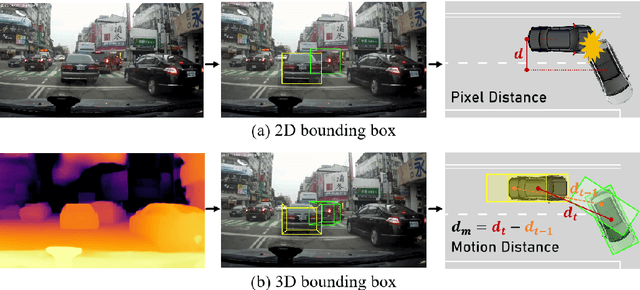

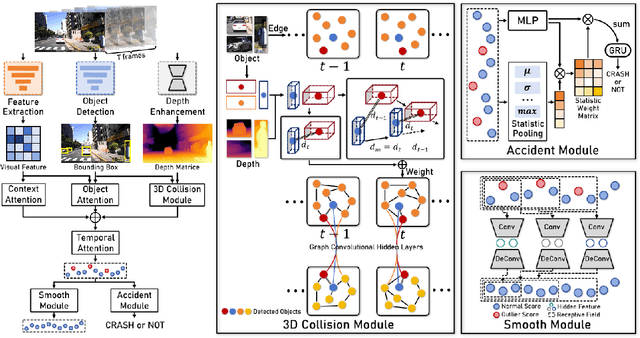

Abstract:The primary goal of traffic accident anticipation is to foresee potential accidents in real time using dashcam videos, a task that is pivotal for enhancing the safety and reliability of autonomous driving technologies. In this study, we introduce an innovative framework, AccNet, which significantly advances the prediction capabilities beyond the current state-of-the-art (SOTA) 2D-based methods by incorporating monocular depth cues for sophisticated 3D scene modeling. Addressing the prevalent challenge of skewed data distribution in traffic accident datasets, we propose the Binary Adaptive Loss for Early Anticipation (BA-LEA). This novel loss function, together with a multi-task learning strategy, shifts the focus of the predictive model towards the critical moments preceding an accident. {We rigorously evaluate the performance of our framework on three benchmark datasets--Dashcam Accident Dataset (DAD), Car Crash Dataset (CCD), and AnAn Accident Detection (A3D), and DADA-2000 Dataset--demonstrating its superior predictive accuracy through key metrics such as Average Precision (AP) and mean Time-To-Accident (mTTA).
KoMA: Knowledge-driven Multi-agent Framework for Autonomous Driving with Large Language Models
Jul 19, 2024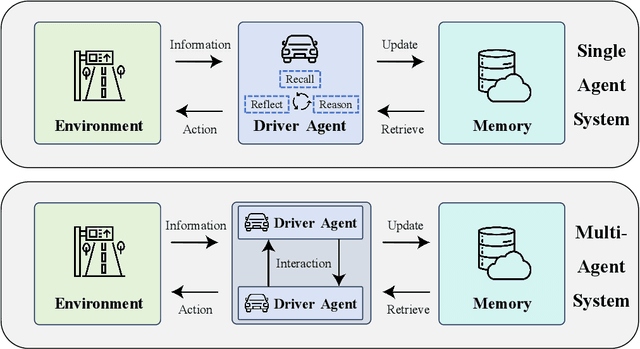
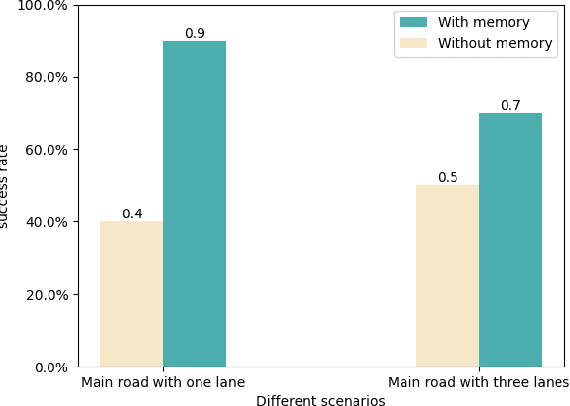
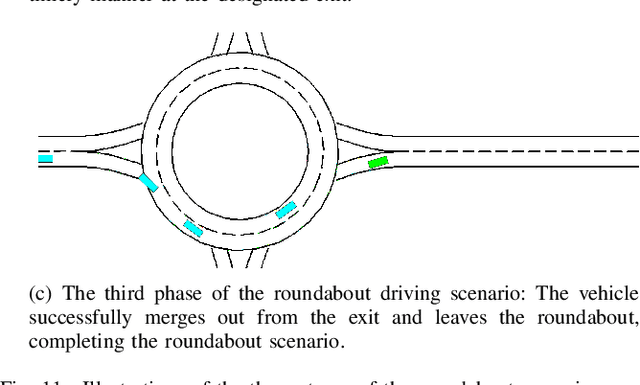
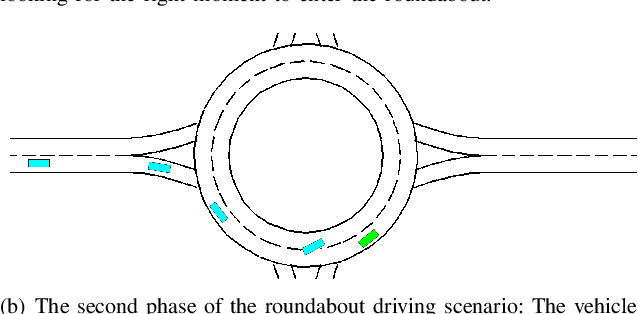
Abstract:Large language models (LLMs) as autonomous agents offer a novel avenue for tackling real-world challenges through a knowledge-driven manner. These LLM-enhanced methodologies excel in generalization and interpretability. However, the complexity of driving tasks often necessitates the collaboration of multiple, heterogeneous agents, underscoring the need for such LLM-driven agents to engage in cooperative knowledge sharing and cognitive synergy. Despite the promise of LLMs, current applications predominantly center around single agent scenarios. To broaden the horizons of knowledge-driven strategies and bolster the generalization capabilities of autonomous agents, we propose the KoMA framework consisting of multi-agent interaction, multi-step planning, shared-memory, and ranking-based reflection modules to enhance multi-agents' decision-making in complex driving scenarios. Based on the framework's generated text descriptions of driving scenarios, the multi-agent interaction module enables LLM agents to analyze and infer the intentions of surrounding vehicles, akin to human cognition. The multi-step planning module enables LLM agents to analyze and obtain final action decisions layer by layer to ensure consistent goals for short-term action decisions. The shared memory module can accumulate collective experience to make superior decisions, and the ranking-based reflection module can evaluate and improve agent behavior with the aim of enhancing driving safety and efficiency. The KoMA framework not only enhances the robustness and adaptability of autonomous driving agents but also significantly elevates their generalization capabilities across diverse scenarios. Empirical results demonstrate the superiority of our approach over traditional methods, particularly in its ability to handle complex, unpredictable driving environments without extensive retraining.
Less is More: Efficient Brain-Inspired Learning for Autonomous Driving Trajectory Prediction
Jul 09, 2024Abstract:Accurately and safely predicting the trajectories of surrounding vehicles is essential for fully realizing autonomous driving (AD). This paper presents the Human-Like Trajectory Prediction model (HLTP++), which emulates human cognitive processes to improve trajectory prediction in AD. HLTP++ incorporates a novel teacher-student knowledge distillation framework. The "teacher" model equipped with an adaptive visual sector, mimics the dynamic allocation of attention human drivers exhibit based on factors like spatial orientation, proximity, and driving speed. On the other hand, the "student" model focuses on real-time interaction and human decision-making, drawing parallels to the human memory storage mechanism. Furthermore, we improve the model's efficiency by introducing a new Fourier Adaptive Spike Neural Network (FA-SNN), allowing for faster and more precise predictions with fewer parameters. Evaluated using the NGSIM, HighD, and MoCAD benchmarks, HLTP++ demonstrates superior performance compared to existing models, which reduces the predicted trajectory error with over 11% on the NGSIM dataset and 25% on the HighD datasets. Moreover, HLTP++ demonstrates strong adaptability in challenging environments with incomplete input data. This marks a significant stride in the journey towards fully AD systems.
OccSora: 4D Occupancy Generation Models as World Simulators for Autonomous Driving
May 30, 2024
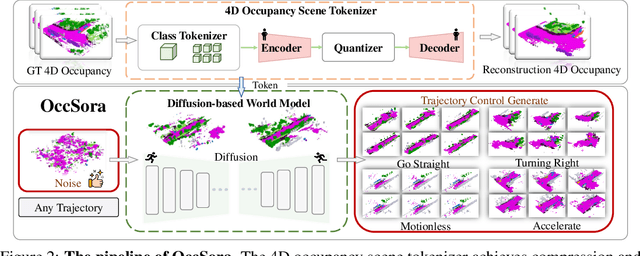


Abstract:Understanding the evolution of 3D scenes is important for effective autonomous driving. While conventional methods mode scene development with the motion of individual instances, world models emerge as a generative framework to describe the general scene dynamics. However, most existing methods adopt an autoregressive framework to perform next-token prediction, which suffer from inefficiency in modeling long-term temporal evolutions. To address this, we propose a diffusion-based 4D occupancy generation model, OccSora, to simulate the development of the 3D world for autonomous driving. We employ a 4D scene tokenizer to obtain compact discrete spatial-temporal representations for 4D occupancy input and achieve high-quality reconstruction for long-sequence occupancy videos. We then learn a diffusion transformer on the spatial-temporal representations and generate 4D occupancy conditioned on a trajectory prompt. We conduct extensive experiments on the widely used nuScenes dataset with Occ3D occupancy annotations. OccSora can generate 16s-videos with authentic 3D layout and temporal consistency, demonstrating its ability to understand the spatial and temporal distributions of driving scenes. With trajectory-aware 4D generation, OccSora has the potential to serve as a world simulator for the decision-making of autonomous driving. Code is available at: https://github.com/wzzheng/OccSora.
Traj-LLM: A New Exploration for Empowering Trajectory Prediction with Pre-trained Large Language Models
May 08, 2024



Abstract:Predicting the future trajectories of dynamic traffic actors is a cornerstone task in autonomous driving. Though existing notable efforts have resulted in impressive performance improvements, a gap persists in scene cognitive and understanding of the complex traffic semantics. This paper proposes Traj-LLM, the first to investigate the potential of using Large Language Models (LLMs) without explicit prompt engineering to generate future motion from agents' past/observed trajectories and scene semantics. Traj-LLM starts with sparse context joint coding to dissect the agent and scene features into a form that LLMs understand. On this basis, we innovatively explore LLMs' powerful comprehension abilities to capture a spectrum of high-level scene knowledge and interactive information. Emulating the human-like lane focus cognitive function and enhancing Traj-LLM's scene comprehension, we introduce lane-aware probabilistic learning powered by the pioneering Mamba module. Finally, a multi-modal Laplace decoder is designed to achieve scene-compliant multi-modal predictions. Extensive experiments manifest that Traj-LLM, fortified by LLMs' strong prior knowledge and understanding prowess, together with lane-aware probability learning, outstrips state-of-the-art methods across evaluation metrics. Moreover, the few-shot analysis further substantiates Traj-LLM's performance, wherein with just 50% of the dataset, it outperforms the majority of benchmarks relying on complete data utilization. This study explores equipping the trajectory prediction task with advanced capabilities inherent in LLMs, furnishing a more universal and adaptable solution for forecasting agent motion in a new way.
A Cognitive-Driven Trajectory Prediction Model for Autonomous Driving in Mixed Autonomy Environment
Apr 26, 2024Abstract:As autonomous driving technology progresses, the need for precise trajectory prediction models becomes paramount. This paper introduces an innovative model that infuses cognitive insights into trajectory prediction, focusing on perceived safety and dynamic decision-making. Distinct from traditional approaches, our model excels in analyzing interactions and behavior patterns in mixed autonomy traffic scenarios. It represents a significant leap forward, achieving marked performance improvements on several key datasets. Specifically, it surpasses existing benchmarks with gains of 16.2% on the Next Generation Simulation (NGSIM), 27.4% on the Highway Drone (HighD), and 19.8% on the Macao Connected Autonomous Driving (MoCAD) dataset. Our proposed model shows exceptional proficiency in handling corner cases, essential for real-world applications. Moreover, its robustness is evident in scenarios with missing or limited data, outperforming most of the state-of-the-art baselines. This adaptability and resilience position our model as a viable tool for real-world autonomous driving systems, heralding a new standard in vehicle trajectory prediction for enhanced safety and efficiency.
 Add to Chrome
Add to Chrome Add to Firefox
Add to Firefox Add to Edge
Add to Edge